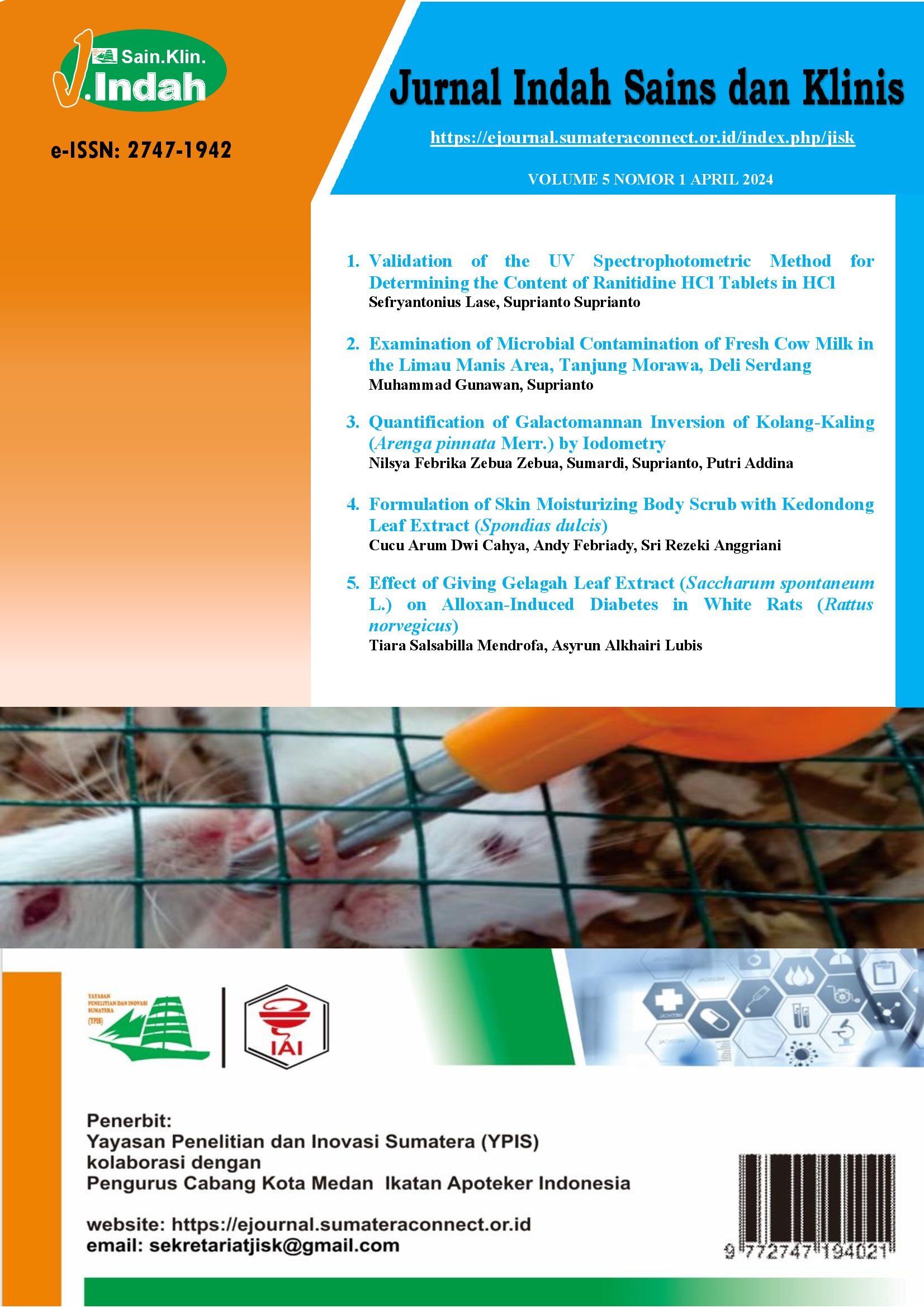Effect of Giving Gelagah Leaf Extract (Saccharum spontaneum L.) on Alloxan-Induced Diabetes in White Rats (Rattus Norvegicus).
DOI:
https://doi.org/10.52622/jisk.v5i1.05Keywords:
Antidiabetic, Saccharum spontaneum leaves extract dose, Blood glucose level reducerAbstract
Saccharum spontaneum L. (Family: Poaceae) is a tall perennial grass with deep roots and rhizomes, capable of growing up to 3-4 meters in height, and is commonly found along water bodies or roadsides. This plant is widely distributed throughout the tropical regions of Asia, Africa, America, and Australia. Saccharum spontaneum L. is a tall, erect, perennial grass with feathery inflorescences, often growing in swampy areas. Its leaves and stems contain lignin, carbohydrates, proteins, and amino acids, while its roots and lower stems contain starch and polyphenolic compounds. This study aims to evaluate the effect of Saccharum spontaneum L. leaves extract on blood glucose levels in male white rats (Rattus norvegicus) induced with alloxan. The leaves extract was obtained through maceration using 96% ethanol solvent. Phytochemical screening results indicated that the leaves of Saccharum spontaneum L. contain alkaloids, flavonoids, saponins, tannins, and steroids/triterpenoids. The antidiabetic test was conducted using male Wistar rats. In this study, the Saccharum spontaneum L. leaves extract was administered in three different doses: group 4 received a dose of 100 mg/KgBW, group 5 received a dose of 200 mg/KgBW, and group 6 received a dose of 400 mg/KgBW. Additionally, there were control groups consisting of group 1 (normal), group 2 (negative control), and group 3 (positive control) which were given the drug glibenclamide 5 mg/60 kg. All doses were administered orally. Diabetes induction in the rats was performed using alloxan monohydrate at a dose of 100 mg/KgBW administered intraperitoneally. The results of the study showed that the greatest reduction in blood glucose levels occurred in group 6 with a dose of 400 mg/KgBW, which decreased blood glucose levels by 71.78% at the 180th minute. Group 5 showed a reduction of 55.80% and group 4 showed a reduction of 51.91% at the 180th minute. Group 3, which was given glibenclamide, showed a reduction in blood glucose levels of 71.14% at the 180th minute. These results indicate that the highest dose of Saccharum spontaneum L. leaves extract (400 mg/KgBW) had the most significant effect in lowering blood glucose levels in male Wistar rats induced with alloxan monohydrate
Downloads
References
S. W. Saputri, A. N. W. Pratama, and D. Holidah, “Studi Pengobatan Diabetes Melitus Tipe 2 dengan Komplikasi Hipertensi di Instalasi Rawat Jalan RSU Dr. H. Koesnadi Bondowoso Periode Tahun 2014,” Pustaka Kesehat., vol. 4, no. 3, pp. 479–483, 2016.
P. T. Amalia, “Uji Efek Penurunan Glukosa Darah Ekstak Etanol Ganggang Merah (Gracilaria verrucosa) dan Kappaphycus alvarezii dengan Metode Toleransi Glukosa Oral dan Metode Induksi Aloksan terhadap Tikus Putih Jantan,” UIN Syarifhidayatullah, Jakarta, 2012.
M. Yassir and A. Asnah, “Pemanfaatan Jenis Tumbuhan Obat Tradisonal di Desa Batu Hamparan Kabupaten Aceh Tenggara,” Biot. J. Ilm. Biol. Teknol. dan Kependidikan, vol. 6, no. 1, pp. 17–34, 2019.
Perkeni, Konsensus Pengelolaan dan Pencegahan Diabetes Mellitus Tipe 2 di Indonesia 2015. Jakarta: Perkumpulan Endokrinologi Indonesia, 2015.
Ministry of Health of the Republic of Indonesia, The Indonesian Health Profile 2018. Jakarta: Ministry of Health, 2018.
S. Sarno, “Pemanfaatan Tanaman Obat (Biofarmaka) sebagai Produk Unggulan Masyarakat Desa Depok Banjarnegara,” Abdimas Unwahas, vol. 4, no. 2, pp. 73–78, 2019.
A. Adriadi, N. Nursanti, and R. Puspitasari, “Keanekaragaman Tumbuhan Obat Masyarakat Di Hutan Talang Rencong Desa Pulau Sangkar, Kabupaten Kerinci, Jambi,” Media Konserv., vol. 25, no. 2, pp. 134–139, 2020.
P. Pebriani and G. Muhammad, “Analisis Dampak Tanaman Gelagah (Saccharum spontaneum) terhadap Laju Erosi Tanah Di Kawasan Bandung Timur,” UIN Sunan Gunung Djati, Bandung.
M. Febrina and Nurhariyati, “Pengaruh Pemberian Infus Batang Gelagah (Saccharum spontaneum L .) terhadap Kadar Glukosa Darah Mencit Putih (Mus musculus L .) Jantan ynag Diinduksi Glukosa,” vol. 10, no. 1, pp. 27–32, 2021.
H. Assung and M. K. Bharali, “In-vivo Antidiabetic Activity of Saccharum Spontaneum on STZ-Induced Diabetic Mice,” J. Pharm. Res. Int., vol. 33, no. 62B, pp. 192–200, 2021.
J. A. I. Devi, K. Madhumitha, and N. Venkateshan, “Studies on the Antimicrobial Activity of Ethanolic Extract of Whole Plant of Saccharum Spontaneum (Linn.),” Am J Pharm Heal. Res, vol. 6, p. 9, 2018.
C. A. S. Kumar, R. Varadharajan, P. Muthumani, R. Meera, P. Devi, and B. Kameswari, “Psychopharmacological Studies on The Stem of Saccharum spontaneum,” Int. J. PharmTech Res., vol. 2, no. 1, pp. 319–321, 2010.
A. Yuriska F, “Efek Aloksan Terhadap Kadar Glukosa Darah Tikus Wistar.” Universitas Diponegoro, Semarang, 2009.
Y. Cahyana and T. Adiyanti, “Flavonoids as Antidiabetic Agents,” Indones. J. Chem., vol. 21, no. 2, pp. 512–526, 2021.
I. Fatima, S. Kanwal, and T. Mahmood, “Evaluation of Biological Potential of Selected Species of Family Poaceae from Bahawalpur, Pakistan,” BMC Complement. Altern. Med., vol. 18, no. 27, pp. 1–13, 2018.
Downloads
Published
Issue
Section
License
Copyright (c) 2024 Jurnal Indah Sains dan Klinis

This work is licensed under a Creative Commons Attribution-NonCommercial-ShareAlike 4.0 International License.









 This work is licensed under a
This work is licensed under a 
